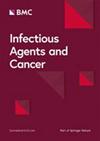应用新一代宏基因组测序技术在淋巴瘤患者化疗相关性间质性肺炎的支气管肺泡灌洗液中检测到高概率的乙氏肺囊虫
IF 3.1
2区 医学
Q3 IMMUNOLOGY
引用次数: 0
摘要
以往的研究表明,淋巴瘤合并间质性肺炎(IP)化疗后的微生物检出率较低。然而,宏基因组下一代测序(mNGS)是一种全面的方法,有望提高病原体的鉴定率。到目前为止,关于mNGS在淋巴瘤化疗相关IP患者中的应用的报道仍然很少。在本研究中,我们通过mNGS检测支气管肺泡灌洗液(BALF),总结了化疗相关IP淋巴瘤患者的微生物检测结果。我们对15例化疗相关IP淋巴瘤患者进行了传统的实验室微生物学检测,同时检测了BALF的mNGS。然后,比较mNGS与传统实验室微生物学的结果。在15例入组患者中,11例接受利妥昔单抗治疗,8例接受盐酸阿霉素脂质体治疗。总微生物产量mNGS为93.3%(14/15),传统培养为13.3% (2/15)(P≤0.05)。检出最多的致病菌为吉氏肺囊虫(12/15,80%)、巨细胞病毒(4/15,26.7%)和eb病毒(3/15,20%)。混合感染10例。5例患者在不使用糖皮质激素的情况下使用抗生素治疗后康复。我们通过mNGS检测BALF的结果表明,化疗后淋巴瘤IP患者的微生物检出率很高。其中,耶氏肺囊虫的检出率特别高。mNGS在化疗相关IP患者中的应用更为敏感。本文章由计算机程序翻译,如有差异,请以英文原文为准。
Pneumocystis jirovecii with high probability detected in bronchoalveolar lavage fluid of chemotherapy-related interstitial pneumonia in patients with lymphoma using metagenomic next-generation sequencing technology
Previous studies achieved low microbial detection rates in lymphoma patients with interstitial pneumonia (IP) after chemotherapy. However, the metagenomic next-generation sequencing (mNGS) is a comprehensive approach that is expected to improve the pathogen identification rate. Thus far, reports on the use of mNGS in lymphoma patients with chemotherapy-related IP remain scarce. In this study, we summarized the microbial detection outcomes of lymphoma patients with chemotherapy-related IP through mNGS testing of bronchoalveolar lavage fluid (BALF). Fifteen lymphoma patients with chemotherapy-related IP were tested for traditional laboratory microbiology, along with the mNGS of BALF. Then, the results of mNGS and traditional laboratory microbiology were compared. Of the 15 enrolled patients, 11 received rituximab and 8 were administered doxorubicin hydrochloride liposome. The overall microbial yield was 93.3% (14/15) for mNGS versus 13.3% (2/15) for traditional culture methods (P ≤ 0.05). The most frequently detected pathogens were Pneumocystis jirovecii (12/15, 80%), Cytomegalovirus (4/15, 26.7%), and Epstein-Barr virus (3/15, 20%). Mixed infections were detected in 10 cases. Five patients recovered after the treatment with antibiotics alone without glucocorticoids. Our findings obtained through mNGS testing of BALF suggested a high microbial detection rate in lymphoma patients with IP after chemotherapy. Notably, there was an especially high detection rate of Pneumocystis jirovecii. The application of mNGS in patients with chemotherapy-related IP was more sensitive.
求助全文
通过发布文献求助,成功后即可免费获取论文全文。
去求助
来源期刊

Infectious Agents and Cancer
ONCOLOGY-IMMUNOLOGY
CiteScore
5.80
自引率
2.70%
发文量
54
期刊介绍:
Infectious Agents and Cancer is an open access, peer-reviewed online journal that encompasses all aspects of basic, clinical, epidemiological and translational research providing an insight into the association between chronic infections and cancer.
The journal welcomes submissions in the pathogen-related cancer areas and other related topics, in particular:
• HPV and anogenital cancers, as well as head and neck cancers;
• EBV and Burkitt lymphoma;
• HCV/HBV and hepatocellular carcinoma as well as lymphoproliferative diseases;
• HHV8 and Kaposi sarcoma;
• HTLV and leukemia;
• Cancers in Low- and Middle-income countries.
The link between infection and cancer has become well established over the past 50 years, and infection-associated cancer contribute up to 16% of cancers in developed countries and 33% in less developed countries.
Preventive vaccines have been developed for only two cancer-causing viruses, highlighting both the opportunity to prevent infection-associated cancers by vaccination and the gaps that remain before vaccines can be developed for other cancer-causing agents. These gaps are due to incomplete understanding of the basic biology, natural history, epidemiology of many of the pathogens that cause cancer, the mechanisms they exploit to cause cancer, and how to interrupt progression to cancer in human populations. Early diagnosis or identification of lesions at high risk of progression represent the current most critical research area of the field supported by recent advances in genomics and proteomics technologies.
 求助内容:
求助内容: 应助结果提醒方式:
应助结果提醒方式:


